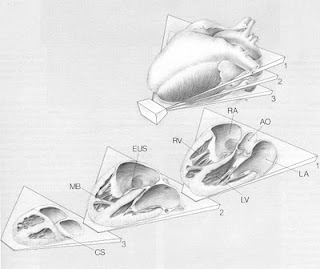Since this is less common in children, less information is available in pediatric patients.
Three methods - Assessment of AR severity
1. LV size & function
- LVEDD, LVESD, LVEDV, LVESV, FS & EF
- LV Mass Mass/Vol. Ratio
Mass/Vol. Ratio: (Li et al. Am Soc Echo 7:S26, 1994)
Pure AS = 1.9 ± 0.7
AS & AR = 1.4 ± 0.4
Normal = 1.18 ± 0.3
2. Indirect Doppler indicators
- CW of AR jet for Deceleration rate & Timing of deceleration.
- PW of Aortic flow. (DTAo. and DAAo.) VTI of Forward flow / Reverse flow
3. Direct measurements by color Doppler
- AR jet by color (Jet & LVOT width)
- Measurement of RV, RF, & EROA.
General comments:
- Children with AS & AR developed symptoms and EKG changes earlier than those with AS only.
- Symptoms and EKG changes were present in all children with Mass/Vol. Ratio > 2.1 in AS and >1.4 in AS with AR. EKG changes help to identify children at increased risk of developing subendocardial ischemia.
Severity of AR by Doppler methods
(All of this data is from adult studies. Preferable to not use this in infants with faster heart rate):
1. VTI Reverse / Forward flow in Ao
(Applies to both DTAo & DAAo by PW)
Mild - 8.9 ± 2.9 (1+)
Moderate - 23.6 ± 4.2 (2+)
Severe - 35.7 ± 5.9 (3+)
50.2 ± 6.5 (4+)
2. Deceleration slope
Mild - < 3 m/s2
3. Pressure half-time
Mild: > 400 ms
Severe: < 400 ms (=40% Regurgitant Fraction)
4. AR jet width / LVOT width
Mild - 19%
Moderate - 30%
Severe - 56% (3+)
80% (4+)
None of the following 3 are of any predictive value.
AR jet by color Doppler:
1) Length
2) Width
3) Area
Width of the jet / Width of LVOT from Parasternal long and short axis views (ref: Perry et al. JACC 9:952, 1987)
Area of jet / Area of LVOT in parasternal short axis
Limitations: The jet is not always circular, widens significantly after the orifice., especially of the gradient was high.
Direct measurements RV, RF and EROA:
By PW method:
Flow = CSA ´ VTI
RV = FlowAoV - FlowPV
RF = RV / FlowAoV
Shown to be accurate in predicting RV and RF.
(Ref: JACC 7: 1273, 1986, Circ 87:841, 1993 and JACC 23:443, 1993.)
By 2D and PW Doppler:
Forward SV = LVEDV - LVSDV
C.O. CSA ´ VTI (via MV or PV)
RV = Forward SV - C.O.
EROA = RV / VTI of Regurgitant jet by CW.
EROA > 25-30 mm2 correlates with severe AR in surgry.
By color Doppler (PISA) technique:
EROA = Regurgitant flow / Regurgitant velocity = 2p2 ´ VAL /Vo.
Regurgitant SV (RV) = EROA ´ VTI by CW.



































